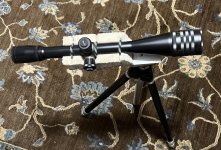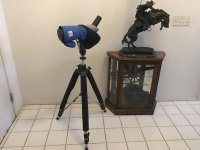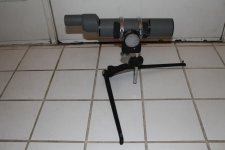Thats why I am a Leupold guy and are on all of my guns. They really perform well with low light conditions.
I need a spotting scope myself,wonder if Leopold spotting scopes are great in low light also.
I have the Leupold SX-2 HD as mentioned above.
Low light performance depends on a few things.
1) Objective lens diameter.
Objective lens diameter along with lens quality is what determines resolution of the scope and diameter along with light gathering ability. An 80mm scope has 5,027 sq mm of surface area, while a 60mm scope has just 2,827 sq mm. That extra 20mm of objective lens diameter almost doubles the surface area and the amount of light it can gather.
2) Lens coatings.
Lens coatings make a huge difference. There may be 6-7 lenses in the average spotting scope and each uncoated lens surface can reflect about 10% of the light passing through it. In other words, you might only get around 25% of the original light passing through a “coated” lens scope.
“Fully coated” is better as it means each lens surface is coated. However, a single coating will only be optimized for a single wavelength of light.
What you want are “fully multicoated” lenses.
Even then the quality of the coatings will vary. For sample Leupold has the “advanced optical system” in tje SX-2 while the SX-4 has the “elite optical system”. (They also have a “professional grade optical system”.) Most of the difference with the SX-4 is the ED (extremely low dispersion) glass that reduces chromatic aberration***, but some of it might be a minor improvement in the lens coatings.
I’ve tried to find the light transmission numbers for the various systems and can’t. But even several years ago, Leupold’s standard lens coatings were 98.5 efficient. 1.5% loss through each of 10 lens surfaces is still going to give about 87% light through put. If you bump that up to 99.5% efficiency then the throughput rises to 95% with 10 lens surfaces. Is 8% more light worth the extra gouge? That’s for you to decide. On a small 60mm scope that is already low light challenged, it might be. But their lack of published numbers reflects the fact that their “advanced” coatings are probably very efficient already and the juice might not be worth the squeeze for anything higher performing.
3) Exit pupil.
Exit pupil is a function of objective lens diameter and magnification.
Let’s say you are looking at three scopes:
10-40x40mm
20-60x60mm
20-60x80mm
At 20x the 40mm scope will have an exit pupil of 2mm. (40/20=2). That will work fine on a bright sunny day, where your pupil diameter is only 2mm or so. But in low light where your pupil may be 4mm in diameter that small exit pupil will only partially illuminate the fovea (the part that sees fine detail) in your retina. The result will be an image that appears dark and grainy.
The 60mm scope will have a 3mm exit pupil at 20x, and the 80mm scope will have a 4 mm exit pupil.
In low light, with the 80mm scope, with your pupil at 4mm you’ll still be using all of your available retina and will get an image that appears much brighter and sharper. In other words, the best lens coatings in the world won’t do much for you of the objective lens and magnification are creating an exit pupil that is too small to fully illuminate your eye under those low light conditions.
*** I mentioned chromatic aberration above and what that means in a spotting scope will be some purple fringing around very bright objects. For example I might be looking at a bright white water tower a mile away and see a faint purple halo around the edges, but usually only at higher magnifications above 40x on my 20-60x80mm scope. Chromatic abberation won’t bother most users and they will only notice it on objects like that.
Theoretically the images won’t be as sharp as the different wavelengths of red, blue and green light will come to focus at three slightly different focal lengths, so focus is always a compromise. But in a 40 to 80mm spotting scope it will not be the limiting factor. In my 6” refractor out in the back yard, it’s a bigger deal.
———
The larger objective lens also means that you can use more of the maximum magnification in the available light. Buy the 10-20x40mm scope and you’ll rarely use more than 15x before the image starts to get dimmer and grainier. With the 60mm scope you’ll have 20-25x that’s actually useable on the average day. With the 80mm scope you’ll be using 30x with the same relative brightness and clarity as the 40mm guy at 15x and the 60mm guy at 23x.
In other words, the large objective is also getting you both more results on and more useable magnification in addition to better low light performance.
From that perspective, when low light performance matters, spend the money on a larger objective rather than the latest and greatest lens coatings (above a certain point).
——
I have an observatory in the back yard and I’m a bit of an optics snob, but I went with the Leupold SX-2 Alpine 20-60x80mm.
It’s been an excellent spotting scope, with great color transmission, great image sharpness, great low light performance, smooth, precise focusing and comfortable eye relief.





